- COURSES
- SPECIALS
- BLOG
- MEMBERS
- SHOP
- ABOUT
- ENROLL HERE
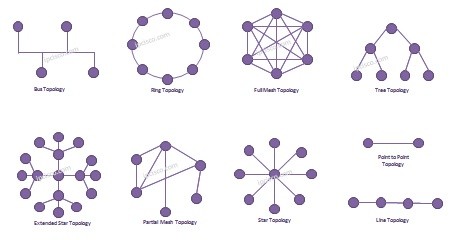
Table of Contents
Basically a network topology means that, connection style of the network nodes. To build a Network, we need a network topolog. There are different LAN Network Topologies that can be used for different network scenarios. What are these Network Topologies?
These Network Topologies can be summarized like below :

You can test yourself with CCNA Practice Questions!
Bus Topology is the simplest LAN Network Topology. With Bus Topology, all the network nodes are connected to a common network media and only one node can receive and transmit data at a time.
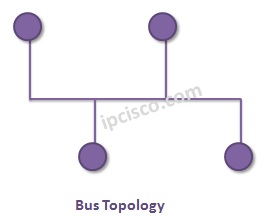
You can also watch Network Topologies Video Lesson below (Members Only)
Ring Topology is a little complex topology. All the nodes are connected on a medium and frames are travels through one direction. If a node wants to send data, then it adds to this frame. Ring topology can be used as two different rings. With two ring, each ring can transmit data in different directions. This provides also a redundancy mechanism.

Star Topology is the topology that all the other nodes are connected to a central node. This is a widely used topology but it has a disadvantage that if the central device fails, the other nodes can not communicate.
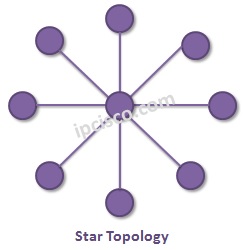
There is also an extended version of Star Topology called Extended Star. In this topology, there are end nodes and sub end nodes. All the sub end nodes are connected to end nodes. And they are conected to the central node.

You can test yourself with CCNA Practice Questions!
Line topology is the topology that all the nodes are connected orderly.
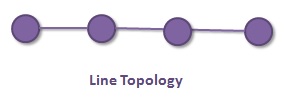
Poin-to-Point Topology is as its name imlies, the topology that connect node to the node. This is one connection and a very widely used topology type.
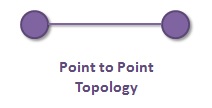
Partial Mesh Topology consist of mesh and point-to-point connections. In this topology, some nodes can be full mesh each other, others can be point to point.
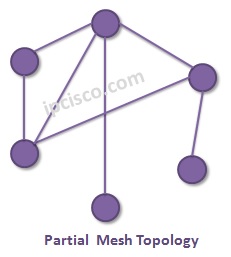
Full Mesh Topology is the most redundant topology. All the nodes are connected eachother in this topology. So, during a network failure in one link, the connection continu through other links. There must be N * (N-1)/2 connections for Full Mesh connections.
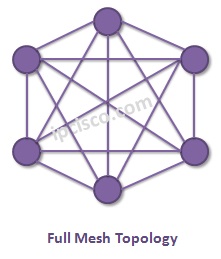
Tree Topology, in other words Hierarhical Topology is consist of a central device and the sub central devices under it. All the Sub central devices are connected to central devices. And the other nodes are connected hierarchicaly below these devices as tree leaves.

A hybrid network topology is a combination of two or more different network topology types to enhance performance, redundancy and scalability. Here the strengths of multiple topologies are integrated in a single topology. Data centers and large scale networks use this technology mostly. There are different hybrid network topologies. Below, you can find dome of these options:
In Star-Bus Hybrid, multiple star networks connected via a central bus. Here each department has its own star setup which is connected to a main backbone.
In Star-Ring Hybrid, star topologies are connected in a ring. This solution provides better fault tolerance and communication between clusters.
In Mesh-Star Hybrid, critical devices use redundant mesh connections, less critical nodes use star topology. This is common in data centers and financial institutions that has critical traffic.
Different topologies has different advantages and disadvantages. Below, you can find a comparison table for different network topology types. In this table, we will compare start topology, mesh topology, bus topology, ring topology, hybrid topology and tree topology.
Star topology is the most common choice for LANs. It is easy to manage, isolate problems and scalable. But if the main hub fails, whole network fails.
Mesh Topology is used in high-reliable networks especially for milltary networks. They are redundant and fault tolerant. But these network types are expensive and complex to install.
Bus topology is a temporary solution for temporary and simple networks. They are cheap and east to set up networks. They are not scalable, hard to troubleshoot, one cable failure can affect all the network, because there is only one common cable.
Ring topology is good for some legacy networks. Their performance is predictable. Here, a single node failure can disrupt the entire ring.
Hybrid Topology is good for modern enterprise networks. They are flexible, scalable, combines benefits of other types. These network types can be complex and expensive.
Tree Topology is good for large networks with hierarchical structure. They are scalable, structured. They are dependent on the root node and need more cabling.
Star Topology is the best option for small and medium networks.
Hybrid Topology is the most flexible and scalable network type for large networks.
Leave a Reply